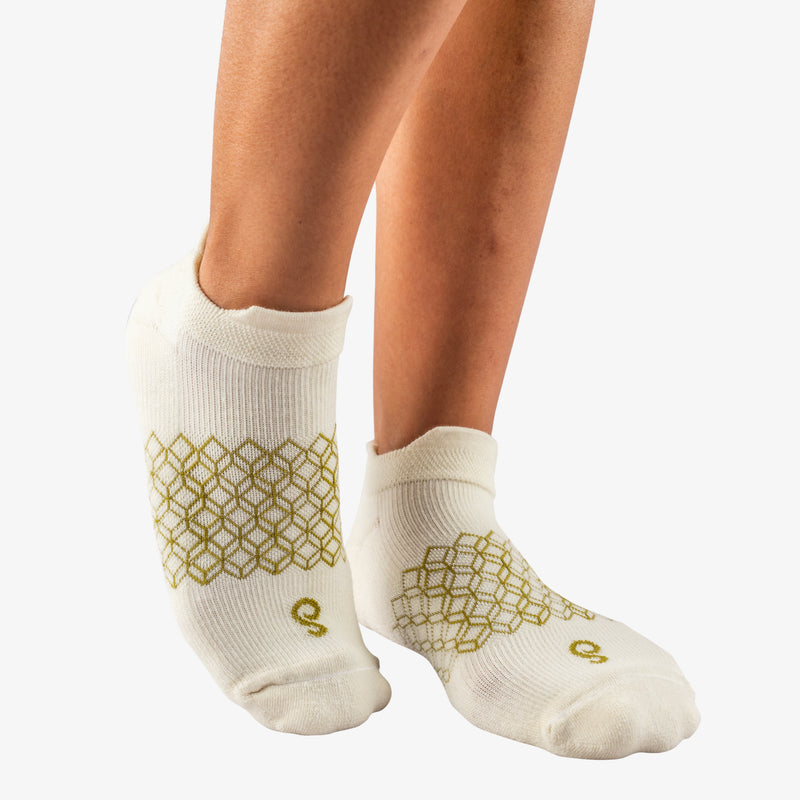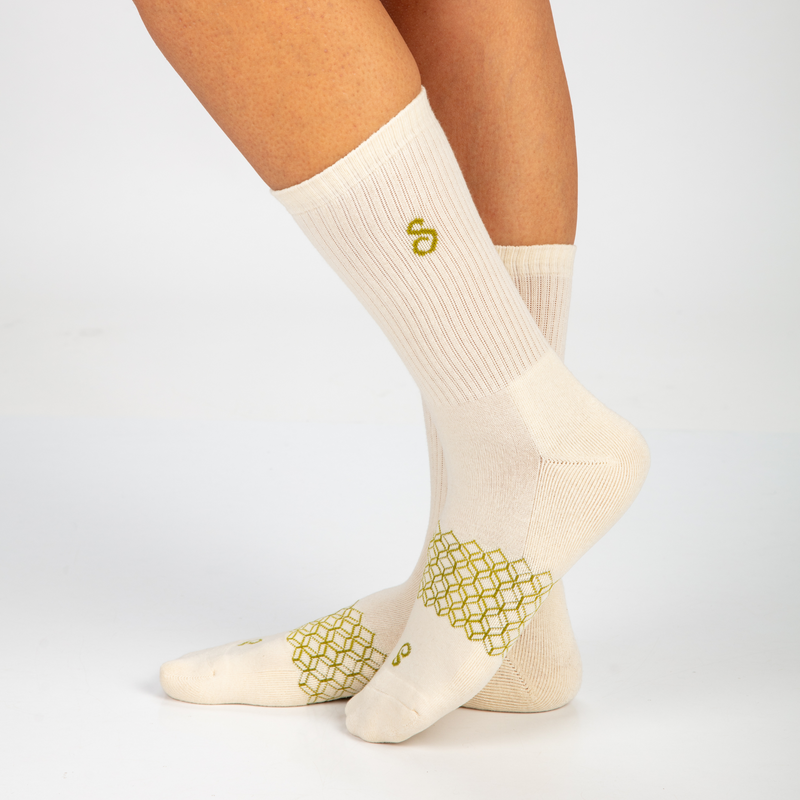
Organic cotton socks offer a sustainable and healthier alternative to conventional cotton socks. They're crafted from cotton grown without synthetic pesticides, artificial fertilisers, or genetic modifications, making them an eco-conscious choice for everyday wear.
These socks are manufactured using cotton that contains no harmful chemical residues, making them particularly suitable for people with sensitive skin or allergies. The natural fibres allow feet to breathe properly, reducing moisture and the risk of fungal infections.
The production of organic cotton supports sustainable farming practices and helps protect soil health, water quality, and biodiversity. Each pair represents a step towards more responsible consumer choices, whilst delivering superior comfort and durability.
Shop hipSwan Organic Cotton Socks →
Benefits of Organic Cotton
Organic cotton offers distinct advantages in environmental preservation, human wellness and sustainable economic practices, setting it apart from conventional cotton production methods.
Environmental Impact
Organic cotton farming eliminates synthetic pesticides and fertilisers, reducing soil and water pollution. These natural practices maintain soil fertility through crop rotation and natural fertilisers.
The cultivation process uses 88% less water than conventional cotton farming, helping preserve vital water resources. Organic methods also reduce greenhouse gas emissions by 46% compared to conventional cotton production.
Organic cotton farms support biodiversity by creating safe habitats for beneficial insects and wildlife. Natural pest control methods protect local ecosystems and maintain environmental balance.
Carbon sequestration improves as organic soils retain more carbon dioxide, contributing to climate change mitigation.
Health Benefits
Organic cotton contains no harmful chemical residues that could irritate sensitive skin or trigger allergic reactions. The absence of toxic pesticides makes it particularly suitable for babies and individuals with skin sensitivities.
Workers on organic cotton farms face significantly lower health risks due to zero exposure to dangerous agricultural chemicals. This protection extends to nearby communities, who benefit from cleaner air and water.
The natural fibres allow better airflow and moisture absorption, reducing the risk of skin infections and discomfort.
Economic Advantages
Organic cotton farmers typically earn 20-30% more than conventional cotton producers through premium pricing and reduced input costs.
Fair trade partnerships often accompany organic cotton production, ensuring workers receive proper wages and better working conditions.
Small-scale farmers benefit from lower production costs as they don't need to purchase expensive synthetic pesticides and fertilisers.
The growing demand for organic cotton creates stable, long-term market opportunities for farming communities.
Production Process
The transformation of organic cotton into comfortable socks involves careful cultivation, precise harvesting, and meticulous manufacturing steps that maintain organic certification throughout the process.
Growing Organic Cotton
Organic cotton farmers use natural fertilisers like compost and manure to nourish the soil. They rotate crops annually to maintain soil health and prevent nutrient depletion.
Natural pest control methods include beneficial insects and companion planting. These environmentally friendly approaches protect the cotton whilst preserving local ecosystems.
The growing cycle spans 150-180 days, with careful monitoring of water usage through efficient irrigation systems. Organic certification requires three years of chemical-free farming before fields qualify.
Harvesting Techniques
Hand-picking remains the preferred method for organic cotton harvest, ensuring the highest quality fibres. Workers carefully select only fully opened cotton bolls, leaving immature ones to develop naturally.
Machine harvesting may be used on larger organic farms, with specially calibrated equipment to minimise damage to the fibres. The timing of harvest is crucial, typically occurring in dry conditions to preserve cotton quality.
Post-harvest sorting removes any damaged bolls or debris, maintaining strict organic standards throughout the process.
From Fibre to Fabric
The cleaned cotton fibres undergo carding to align and straighten them into a continuous strand. This creates a soft, uniform roving ready for spinning.
Spinning mills transform the roving into yarn through a precision process that controls thickness and twist. Organic certification requires separate processing lines to prevent contamination with conventional cotton.
The yarn moves to knitting machines that create the tubular sock shape. Different knitting patterns produce varying levels of cushioning and support.
Dyeing uses certified organic pigments and low-impact methods. The socks undergo quality testing for durability, fit and comfort before packaging.
Design and Style Varieties
Organic cotton socks come in diverse design options, combining visual appeal with practical features. Modern manufacturing techniques enable intricate patterns and precise fits.
Patterns and Colours
Organic cotton socks feature classic solid colours like navy, grey, and black for professional settings. White and cream options serve as wardrobe staples.
However, it is rare to find organic dyes that don't wash away over time and for this reason most coloured "organic cotton" socks involve chemical dyes. Some brands, like hipSwan, offer customers a choice of natural/undyed organic cotton socks.
Striped patterns remain popular, ranging from subtle pinstripes to bold multi-coloured designs. Many brands offer seasonal collections with floral prints, geometric shapes, and artistic motifs.
Ankle-length styles often incorporate playful elements like polka dots or nature-inspired themes. Longer socks tend towards more reserved patterns suitable for formal occasions.
Fitting and Comfort
Organic cotton socks incorporate elastic bands at the top to prevent slipping without restricting circulation. The material's natural stretch allows for consistent fit throughout the day.
Manufacturers offer specific sizing ranges:
- Small (UK 3-5)
- Medium (UK 6-8)
- Large (UK 9-11)
- Extra Large (UK 12-14)
Reinforced heels and toes provide targeted cushioning in high-wear areas. Seamless toe construction prevents friction and irritation during extended wear.
Arch support panels maintain sock position and enhance comfort. The breathable weave creates proper ventilation while preserving warmth.
Care and Maintenance
Proper care and cleaning techniques extend the lifespan of organic cotton socks whilst maintaining their comfort and structural integrity. Regular maintenance preserves the natural fibres and prevents premature wear.
Washing Guidelines
Wash organic cotton socks in cold or lukewarm water at 30°C to protect the natural fibres. Turn the socks inside out before washing to reduce pilling and maintain softness.
Choose mild, eco-friendly detergents free from harsh chemicals and bleach. These gentle cleaners preserve the cotton's natural properties and prevent fibre damage.
Machine washing is acceptable on a gentle cycle. Place socks in a mesh laundry bag to prevent tangling and stretching.
Air-dry the socks flat or on a clothesline away from direct sunlight. Avoid tumble drying, as high heat can shrink the organic cotton and weaken the fibres.
Longevity Tips
Store clean socks in a cool, dry drawer away from direct sunlight to prevent colour fading and fibre degradation. Match pairs immediately after washing to avoid misplaced socks.
Essential Care Practices:
- Replace elasticated socks when they lose their stretch
- Rotate between multiple pairs to extend wear
- Trim loose threads carefully with scissors
- Mend small holes promptly to prevent expansion
Keep toenails trimmed and smooth to reduce friction points and prevent snags in the fabric. Remove shoes carefully to avoid stretching the sock cuffs.
Check socks regularly for signs of wear at pressure points, such as heels and toes. Address any damage promptly to prevent further deterioration.
Consumer Guide
Selecting organic cotton socks requires attention to quality indicators, material certifications, and proper sizing for maximum comfort and durability.
Choosing the Right Socks
When shopping for organic cotton socks, focus on the fabric blend percentages. Pure organic cotton offers maximum breathability, while small amounts of elastane or spandex provide essential stretch.
Look for reinforced heels and toes to prevent premature wear. These areas experience the most friction during daily use.
Consider sock thickness based on your needs. Lightweight options work well for everyday wear, while medium-thickness socks suit cooler weather.
Check the sizing carefully. Proper fit prevents bunching and sliding, with most brands offering small, medium, and large options.
Understanding Certifications
GOTS (Global Organic Textile Standard) certification guarantees organic cotton cultivation without harmful pesticides or chemicals. This certification tracks the entire production process.
The Organic Content Standard (OCS) verifies the presence of organic materials in the final product. Look for the percentage of organic content listed on the label.
Fair Trade certification ensures ethical labour practices and fair wages throughout the manufacturing process.
Oeko-Tex Standard 100 certification confirms the absence of harmful substances in the finished socks.
Frequently Asked Questions
Organic cotton socks come with specific benefits, certifications, care instructions, and design variations that maximise comfort and sustainability.
What are the benefits of wearing organic cotton socks?
Organic cotton socks offer superior breathability and moisture-wicking properties compared to conventional cotton socks.
The absence of harmful chemicals and pesticides makes them ideal for sensitive skin and reduces the risk of allergic reactions.
These socks provide excellent durability due to the stronger, unprocessed cotton fibres used in their construction.
How can you distinguish between 100% organic cotton socks and blends?
Check the product label for the exact percentage of organic cotton content and additional materials used.
Pure organic cotton socks display a natural, slightly irregular texture and feel softer to the touch than blended varieties.
The packaging should list detailed fibre composition, with legitimate organic cotton products carrying proper certification labels.
What are the best practices for caring for organic cotton socks to maintain their quality?
Wash organic cotton socks in cold or lukewarm water using mild, eco-friendly detergents.
Air-dry the socks away from direct sunlight to prevent fibre damage and maintain elasticity.
Turn the socks inside out before washing to protect the outer surface and extend their lifespan.
In what ways are organic cotton socks for children designed differently than adult sizes?
Children's organic cotton socks feature reinforced heel and toe areas to withstand active play and frequent washing.
The elastic bands are typically gentler and wider to prevent leaving marks on children's sensitive skin.
Special attention is paid to seamless toe construction to prevent irritation and discomfort.
What certifications should one look for when purchasing organic cotton socks to ensure quality?
The Global Organic Textile Standard (GOTS) certification guarantees organic cultivation and ethical manufacturing practices.
Organic Content Standard (OCS) verification confirms the precise percentage of organic materials used.
OEKO-TEX® certification ensures the finished product is free from harmful substances.
Why might some socks claim to be organic cotton when they contain other materials?
Many manufacturers blend organic cotton with synthetic fibres to enhance durability and stretch.
Some products marketed as organic may contain as little as 70% organic cotton, with the remainder being conventional cotton or synthetic materials.
Current regulations permit the use of 'organic cotton' labelling even when products contain other materials, provided the cotton portion is organically sourced.

















